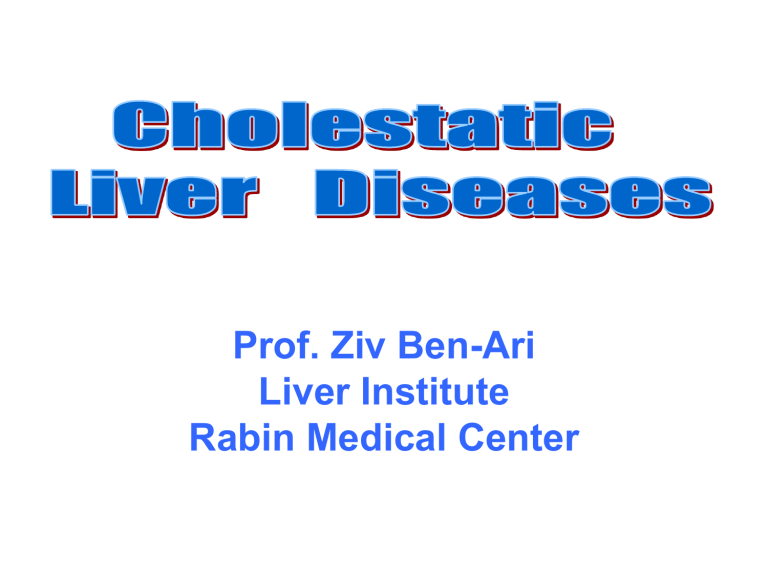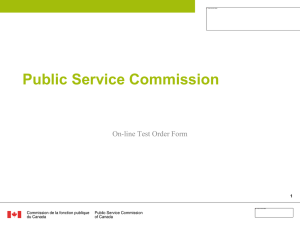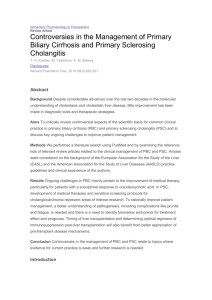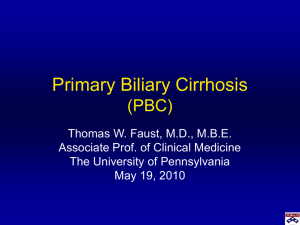Cholestatic Liver Disease

Prof. Ziv Ben-Ari
Liver Institute
Rabin Medical Center
Cholestatic Liver Diseases
• Primary Biliary Cirrhosis (PBC)
• Primary Sclerosing Cholangitis
(PSC)
Case Presentation 1
• A 36 years old male
• Israeli origin
• Was diagnosed 6 years ago as inflammatory bowel disease (ulcerative colitis)
• Pancolitis, 4 years in remission
• Treatment rafassal 500mg x4/d
• A cousin ,was diagnose 1 year ago as crohn’s disease
Case Presentation 1 cont
• On routine check up:
• Hepatomegaly 3cm below costal margin
• No other stigmata of chronic liver disease
• Increase serum cholestatic liver enzymes:
Alk phos 420U/l, GGT 400U/l, AST 42U/l, ALT
50U/l, total bilirubin 1.1 mg/dl, albumin
4.1g/dl, other chemistry results normal, CBC normal
Increased serum cholestatic Vs. hepatocellular liver enzymes
Primary sclerosing cholangitis (PSC)
Definition and epidemiology
• PSC is a rare but important cause of chronic liver disease
• The disease is characterized by chronic inflammation and obliterative fibrosis of the intraand/or extra-hepatic biliary tree which leads to bile stasis, hepatic fibrosis, and cirrhosis
• This can be complicated by portal hypertension, hepatic failure requiring transplantation
• First-degree relatives of patients with PSC have a nearly 100-fold increased risk of developing PSC
Annual incidence rates between 0.9 and 1.3 cases per 100,000 population
Etiology
• PSC occurs primarily in patients with underlying
IBD; 70% to 80% UC
• 2%-7.5% of patients with UC and 1.4% - 3.4% of patients with Crohn’s disease develop PSC
• An increased prevalence of HLA alleles A1, B8, and
DR3 is observed in PSC
• An autoimmune disease
• Homing of memory lymphocytes to the biliary tract;
Colonic inflammation produces memory T cells that have the ability to bind biliary cells
Pathogenesis
ANA Ab and smooth muscle Ab occur in 20% - 50% of patients
AMA are rarely found in patients with PSC
The dominant autoantibodies in PSC is perinuclear antineutrophilic autoantibodies (pANCA), which are found in approximately 80% of patients but lack diagnostic specificity for PSC
The gold standard for the diagnosis of PSC is ERCP
Normal ERCP
The gold standard for the diagnosis of PSC is ERCP
Typical radiologic findings include multifocal strictures and dilation involving the intrahepatic or extrahepatic biliary tract or both, the characteristic “beads-on-a-string” appearance
Radiographic Features
• ERCP is successful in 95% of cases
• 75% have involvement of both small and large ducts, 15% small ducts only, and 10% large ducts only.
• Serious complication pancreatitis, cholangitis, intestinal or bile duct perforation, and bleeding. Risks greater in patients with PSC
MRCP is the best initial approach to diagnosis of PSC
•
Depicting ducts proximal to high grade strictures.
• Provides imaging of the rest of the abdomen.
• MRCP is purely diagnostic, not allowing intervention.
The two methods yield similar sensitivity and specificity in demonstrating bile duct abnormalities leading to the diagnosis of PSC
Periductal fibrosis with inflammation, bile duct proliferation, and ductopenia.
Fibro-obliterative cholangiopathy, periductal fibrosis ( “onion-skinning”) the pathologic hallmark of PSC, is uncommonly observed (13.8%)
The histologic findings of PSC are nonspecific
CLINICAL FEATURES
• Males are twice as commonly affected as females, between
25-45 years of age
• Majority are asymptomatic 15%- 40% of cases,
• ALP is the most commonly elevated X 3-10 times
• AST and ALT levels are usually X 2-3 higher than normal levels
• Serum
-globulin and IgA are increased in 40-50%
• Even asymptomatic the patient may have underlying advanced liver disease: cirrhosis and portal hypertension
• Fever, chills, right upper quadrant pain, itching and jaundice: ascending cholangitis
• One third episodes of bacterial cholangitis especially following biliary interventions in patients with dominant stenosis
Clinical Manifestations
• Fatigue and pruritus are common
• Jaundice and weight loss, or portal hypertension in advanced stages. A rare presentation variceal hemorrhage, end-stage liver disease, or cholangiocarcinoma
• Serum bilirubin usually is normal or slightly elevated, in advanced disease, superimposed malignancy, or choledocholithiasis, serum bilirubin values can reach very high levels
Clinical Presentation of PSC
Symptom
Jaundice
Pruritus
Abdominal pain
Weight loss
Fatigue
Fever/cholangitis
Asymptomatic
% of pts
30-72
28-69
24-72
29-79
65-66
13-45
7-44
Natural history of PSC
Survival in PSC
PSC and IBD
• 70% patients with PSC have IBD as well, typically UC and less commonly Crohn ’s disease with colonic involvement
• IBD is diagnosed before PSC in 75% of cases and afterward in the remainder
• There is no correlation between the severity of PSC and that of the associated IBD
• IBD in PSC is characterized by a high prevalence of pancolitis
• PSC-IBD patients require thorough colonoscopic surveillance with extensive biopsy sampling
• Therapy of IBD has little effect on the course of PSC, and vice versa
Colonic neoplasia
Colorectal neoplasia in PSC-IBD
• The cumulative incidences of colorectal carcinoma at 10, 20, and 25 years in PSC-IBD patients are 5%, 31%, and 50%, respectively
Cholangiocarcinoma
• Cholangiocarcinoma (CCA) occurring in 4%- 20% of PSC patients;
30% to 50% diagnosed within 2 years of identifying PSC
• Serum CA19-9 remains the most used marker for a cutoff of 129
U/mL provided sensitivity of 78.6%, specificity of 98.5%
• US, CT, and MRI have inadequate sensitivity to distinguish cholangiocarcinoma from PSC
• Endoscopic biopsy and biliary brushing for cytology, digital image analysis, and FISH have good specificity but poor sensitivity
• Complete resection is the only treatment offering long-term survival
• Treatment : Neoadjuvant chemoradiotherapy with subsequent liver transplantation
Ursodeoxycholic Acid (UDCA)
• A non-hepato-toxic,hydrophilic bile acid
• It protects cell membranes against the detergent effect of hydrophobic bile acid
• It stimulates the excretion of toxic bile acids
• Reduce HLA class 2 experssion on bile-ducts
• Decrease cytotoxic attack of T-cells on bileducts
Immunosuppressive and other agents
Ursodeoxycholic acid (cont)
• A choleretic effect, direct and indirect cytoprotective effects, immunomodulatory effects, and downregulation of apoptosis
• Treatment with standard-dose (10-15 mg/kg) UDCA did not show significant improvements in histology or survival
• High-dose UDCA (20 –30 mg/kg) might cause an improvement in liver biochemistry, histology, and cholangiographic appearance???.
• Ineffective: D-penicillamine, Colchicine, methotrexate, cyclosporine, and transdermal nicotine, pentoxifylline, silymarin, oral nicotine, pirfenidone, budesonide, cladribine, etanercept, mycophenolate mofetil, glucocorticoids and tacrolimus
Liver Transplantation
• Liver transplantation remains the only proven long term treatment for PSC
• Major indications include: recurrent bacterial cholangitis despite intensive medical and endoscopic therapy, jaundice that cannot be treated endoscopically or medically, decompensated cirrhosis
• The 1-, 2-, and 5-year survival rates for patients who received a first liver allograft for
PSC were 90%, 86%, and 85%, respectively
• PSC recurred in 37% of patients at a median of 36 months
PSC patient ’s survival after liver transplantation
In our patient
• Previous diagnosis of IBD
• Increased cholestatic liver enzymes
• Hepatomegaly
• Proceed to ERCP/MRCP (preferable)
• No need for a liver biopsy for diagnosing
PSC
In our patient
• URSO (25mg/kg) (select the higher dose)
• Periodical follow-up visits to hepatology/GI clinic
• In case liver cirrhosis develop – consider liver transplantation
• Check periodically serum markers for cholangiocarcinoma (CA19-9)
Case Presentation 2
• 46 years old female
• Born in Ucreinia, 32 years in Israel
• Medical history: rec UTI ’s
• On routine check-up tests incrased serum cholestatic liver enzymes : ALP 480U/L,
GGT 380U/L, normal transaminases, total bilirubin 1mg/dl, albumin 4.1g/dl, protein
8.1g/dl
Case Presentation 1 cont
• Medical history: no pruritus, rec UTI due to
E. coli, no drugs, mother had hypothyroidism
• Laboratory tests: autoAb ’s
(ANA,AMA,ANCA), Ig ’s (IgG&IgM), r/o other etiologies, serology for hepatitis C and B
• Imaging – abdominal U/S
Primary Biliary Cirrhosis
• A slowly progressive autoimmune disease, primarily affects women
• Peak incidence in the fifth decade of life, uncommon < 25 years
• Histopathologically characterized by portal inflammation and immune-mediated destruction of the intrahepatic bile ducts
• Loss of bile ducts leads to decreased bile secretion and the retention of toxic substances within the liver, resulting in fibrosis, cirrhosis, and eventually, liver failure
• Serologically characterized by AMA, present in 90 – 95% of patients, detectable years before clinical signs appear
• The immune attack is predominantly organ-specific, although the AMA are found in all nucleated cells
The prevalence differs considerably in different geographic areas, ranging from 40 to
400 per million
Pathogenesis
• The paradox of PBC is that mitochondrial proteins are present in all nucleated cells, yet the autoimmune attack is directed with high specificity to the biliary epithelium.
• The specificity of pathological changes in the bile ducts, the presence of lymphoid infiltration in the portal tracts, and the presence of major-histocompatibility
-complex class II antigen on the biliary epithelium suggest that an intense autoimmune response is directed against the biliary epithelial cells.
• The destruction of biliary cells is mediated by liver-infiltrating autoreactive T cells
Epidemiologic and genetic factors
• PBC is considerably more common in first-degree relatives of patients than in unrelated persons
• There is little association between PBC and the presence of any particular major-histocompatibility-complex alleles
• There are no clear genetic influences on the occurrence of PBC
• The ratio of women to men with the disease can be as high as
10 to 1
Environmental factors
• Molecular mimicry is the most widely proposed mechanism for the initiation of autoimmunity in PBC
• Bacteria; E coli, elevated incidence of urinary tract infections in patients with PBC and the highly conserved nature of the mitochondrial autoantigens autoantigens.
Antibodies against the human pyruvate dehydrogenase complex react well against the E. coli pyruvate dehydrogenase complex
• Xenobiotic-metabolizing, gram-negative bacterium called
Novosphingobium aromaticivorans. it has four lipoyl domains with striking homology with human lipoylated autoantigens
Pathological findings
The liver is not affected uniformly, and a single biopsy may demonstrate the presence of all four stages at the same time. Asymmetric destruction of the bile ducts within the portal triads
Stage 1 localization of inflammation to the portal triads. In stage 2, the number of normal bile ducts is reduced, and inflammation extends beyond the portal triads into the surrounding parenchyma. In stage 3, fibrous septa link adjacent portal triads. Stage 4 represent endstage liver disease, characterized by cirrhosis with regenerative nodules
Diagnosis
• The diagnosis of PBC is based on three criteria: the presence of detectable AMA in serum, elevation of liver enzymes (most commonly ALP) for more than six months, and compatible histologic findings
• 5-10 % of patients have no detectable AMA, but their disease appears to be identical to that in patients with AMA
• ANA are found in approximately 50 % of patients with PBC
Mitochondrial Antibodies
• Circulating IgG Ab against mitochondria are found in 95% of patients
• They are non-organ and non-species specific. The significance of the AMA and its relationship to the etiology is uncertain
These target antigens are located in the inner mitochondrial membrane
The targets of the AMA are members of the family of the pyruvate dehydrogenase complex (PDC)
The antigenic component specific for PBC is M2
Four M2 antigen polypeptides were identified, all components of the PDC
The dominant epitope recognized by AMA is located within the lipoyl domain
Clinical findings
• PBC is diagnosed earlier in its clinical course; 50 -60% of patients are asymptomatic at diagnosis, one third of patients may remain symptom-free for many years
• Overt symptoms develop within 2-4 years in the majority of asymptomatic patients
Asymptomatic patient
• Routine biochemical screening: ALP
&
GGT
• Survival at least 10 years
• Course is variable and unpredictable
• Some will stay asymptomatic and some will run a progressive downhill course
• Fatigue has been noted in up to 78 % of patients and can be a significant cause of disability
• Pruritus occurs in 20-70 % of patients, can be the most distressing symptom. Onset usually precedes the onset of jaundice by months to years. Endogenous opioids may have a role
• Discomfort in the right upper quadrant occurs in approximately
10% of patients
Clinical findings
• Hyperlipidemia, osteopenia/osteophorosis, and coexisting autoimmune diseases, including Sjogren ’s syndrome, scleroderma and hypothyroidism
• Malabsorption, deficiencies of fat-soluble vitamins, and steatorrhea are uncommon except in advanced disease
• Portal hypertension does not usually occur until later in the course of the disease
• Rarely, patients present with ascites, hepatic encephalopathy, or hemorrhage from esophageal varices
• The incidnece of hepatocellular carcinoma is elevated among patients with long-standing histologically advanced disease
•Other diseases associated with PBC include interstitial pneumonitis, celiac disease, sarcoidosis, renal tubular acidosis, hemolytic anemia, and autoimmune thrombocytopenia
Physical Examination
• Normal in early disease stage
• Might be later: jaundice, hyperpigmentation, xanthelasmas, tendinous & planar xanthomas, hepatomegaly, splenomegaly, clubbing, bone tenderness, ecchymoses
Biochemical tests
• ALP
and GGT
and bilirubin
• Cholesterol
• IgM
Diagnosis
• Middle-aged woman
• Increase cholestatic liver enzymes
(ALP&GGT)
• AMA (M
2
) positive (>1:80)
• Liver biopsy could be performed to confirm the diagnosis and for staging
In Our Patient
• A middle-aged asymptomatic women
• Family history of thyroid disease
• Past history of recurrent UTI
• Elevated ALP & GGT
• Positive M
2, hypercholesterolemia, eyelid xanthelasma
• Normal liver & spleen (abdominal U/S)
• Liver biopsy
Natural history and prognosis
• The prognosis is much better now than it formerly was as a result of treatment in earlier stages of disease
• In at least 25-30 % of patients with PBC who are treated with URSO, a complete response occurs, characterized by normal biochemical test results and stabilized or improved histologic findings in the liver
• In untreated patients, the median time until death or referral for liver transplantation is only 9.3 years
Survival of PBC patients asymptomatic and symptomatic
Treatment of symptoms and complications pruritus
• Ammonium resin cholestyramine, at a dose of 8 to 24 g daily, will relieve pruritus in most patients.
• Rifampin, at a dose of 150 mg twice daily, is effective in patients who do not respond to cholestyramine.
• The opioid antagonists naloxone and naltrexone may be effective in patients who do not respond to cholestyramine or rifampin
Ursodeoxycholic acid (URSO)
• URSO 12-15 mg/kg per day, is the only approved drug
• Improve biochemistry
• URSO significantly reduced the likelihood of liver transplantation or death after four years
• Ursodiol appears to be safe and has few side effects
• It delays the progression of hepatic fibrosis in early-stage
PBC and delays the development of esophageal varices, but it is not effective in advanced disease
• Two meta-analyses questioned the efficacy of ursodiol
• Colchicine and methotrexate Cyclosporine,Azathioprine, mycophenolate, Penicillamine , Chlorambucil
Thalidomide, Silymarin
Effect on UDCA on survival
UDCA-treated
Placebo group
Predicted group
Steroids
• Prednisone has little efficacy and increases the incidence of osteoporosis
• Budesonide improves liver histology and the results of biochemical tests of liver function when used with URSO, but it may worsen osteopenia
Liver Transplantation
• Liver transplantation has greatly improved survival in patients with PBC, and it is the only effective treatment for those with liver failure
• The survival rates are 92% – 85% at one and five years, respectively
• AMA status does not change. PBC recurs in 15 % of patients at 3 years and in 30 % at 10 years
In Our Patient
• URSO in a dosage up to 15 mg/kg until normalization of ALP & GGT achieved
• Bone densitometry
• Serum cholesterol control










